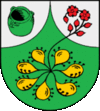Community Seth

Increasing Population
The village Seth is situated in the area of the southern Holsteiner Geest. The sandy ground ist often underlaid with Ortstein, here called Nor. North-easterly the area is flanked by a large raised bog. Some slight sandy hills, typically Holsteiner hedgerow, many old oaks, the mostly agricultural used surface is sectioned into different sized meadows and fields.
The Sether area is located around 30 metres above sea level, the groundwater level is often 70cm to 90cm beneath the surface.
On a map from 1386 villages are marked far away from today's Seth area. The nearest larger depicted village is Borstel, since 1258 so recorded.
In 1588 due to the distribution of the estate among four brothers of squires came apart from Sülfeld, Grabau, Oering and Heidkrug also Seth to Borstel. The Seth inhabitants were bondslaves of the squire. After 1771 the then owner Earl von Bernstorff undertook the first steps to abolishing bondage, which was finally accomplished in 1797; soon after farmers could take over estates as leasehold. In 1849 the lordship of the manor proceeded to sell estates in hereditary leaseholds. These hereditary leaseholds were bonded with many burdens and taxes. The leaseholder had to deliver fuel peat to the school, the Landinsten – Insten was the name for estate workers who did farming side jobs when their homestead amounted up to 5 tons, 25.000 m² – ploughing and harrowing the land, distribute manure, bring in the grain and hay, get and bring the midwife, drive a corpse to the cemetery.
Seth was in the past assigned to the church Sülfeld, where also the dead were buried. The community later built their own cemetery in the village. Burials have been taking place here since 1929; in 1962 a cemetery chapel was inaugurated. In 1971 a new church community was emerged from the villages Seth, Stuvenborn and Sievershütten. The cemetery chapel in Seth was turned 1974/75 into a church. Probably the oldest house in the village, which also served also as a school, stand on the former 'Wischhof' at the Hauptstraße 85.
In the year 1810 a new school was opened. But it burned to the ground in 1909. Already in 1910 a new (today it is the 'old') school could be inaugurated where once the old one was built. After the 2nd World War Seth's population increased so much that the school had to be extended. In 1966 a gym was built on the sports ground; in June 1967 was topping out ceremony for the present 'new' school.
Due to the increasing demands onto the school education the communities Seth, Sülfeld, Tönningstedt and Borstel founded in 1970 a school association. All children from these villages from the 1st to 4th school year were taught in Seth, the secondary students in Sülfeld. Lots of bus travel and time still has to be spent. Students of further education schools have to travel 20 kilometres to Bad Segeberg.

